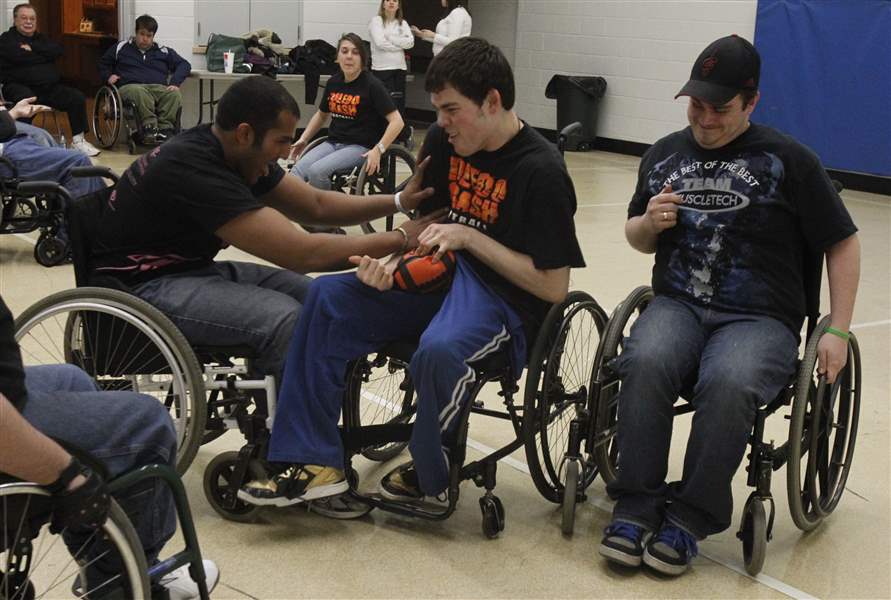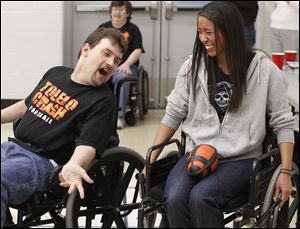
Wheelchair team predicts victory over Rockets
Toledo Crash to play football against UT squad
4/13/2011
Amit Goyao, left, of Toledo, tries to 'tackle' Nick Hyndman, right, a member of the Toledo Crash wheelchair football team from Perrysburg, during a scrimmage with the University of Toledo Rec Therapy Club.
The Blade/Amy E. Voigt
Buy This Image

Amit Goyao, left, of Toledo, tries to 'tackle' Nick Hyndman, right, a member of the Toledo Crash wheelchair football team from Perrysburg, during a scrimmage with the University of Toledo Rec Therapy Club.
Sean O'Mara is at the top of his game.
Although players on the opposing squad are younger, bigger, and more athletic, the 41-year-old Toledoan is predicting that his team, Toledo Crash, will upset the Rockets.
"I am highly competitive. In fact sometimes I hold back a little bit. But not against the University of Toledo. I predict it will be very close, with a Toledo Crash win," Mr. O'Mara said while taking a break at a recent scrimmage.
The Toledo Crash, founded 10 years ago, is a wheelchair team organized by the Ability Center of Northwest Ohio in Sylvania. They will take on members of the UT football team at 2 p.m. Sunday at the UT Recreation Center on campus.
Mr. O'Mara, who was born with cerebral palsy and is among the eight Crash players, has been playing wheelchair football since he was 11 years old. He said he loves the competition because it has opened doors for him to meet people while demonstrating that there are no barriers for people with disabilities.
"I think that in my situation I have gotten great opportunities to meet wonderful people. It is not about winning or losing but about getting out there and competing," said Mr. O'Mara, a UT graduate and member of the Ability Center board of trustees.
The game is played on a regulation basketball court in wheelchairs, either manual or motorized, with five to seven players a side. Players follow basic football rules to move a Styrofoam football down the court into end zones to score points. Each touchdown is worth 6 points.
However, the game has specific rules for three levels of players according to disability.
Level 1 players have fully functioning arms, hands, and eyes. They must catch and hold onto the ball and must touch another player to tackle him and cannot tackle him by touching his chair. Grabbing a chair is considered holding.
The UT football team participates in Level 1.
Level 2 players have limited arm and hand movement or are visually impaired. In catching, the ball must hit them anywhere between the hands and elbows with enough force that some deflection occurs in the flight of the ball -- the ball grazing the hair on a knuckle doesn't count.

Chris Clarke, left, a member of the Toledo Crash wheelchair football team from Toledo, tries to 'tackle' Chelsea Lasater, of Toledo, during a scrimmage with the UT Rec Therapy Club.
Fielding the ball on kickoffs requires having it hit or bounce anywhere into the front of the body or chair, or running over the ball. After "catching" the ball or gaining possession, they can "run" with the ball.
In Level 2, a tackle occurs when a player's body of chair makes contact with an opposing player's body or chair.
A player can recover the ball by trapping it under his chair.
Level 3 players have minimal or no arm movement or are blind. They must abide by the same rules as Level 2 players except in making pass completions. Those require that the player must be hit in the front or side of the body from the waist up or in the back of the head or wheelchair headrest.
Mark Armstrong, a community connections coordinator with the Ability Center, said the rules put players, regardless of handicaps, on equal footing.
"The game allows someone with a disability to compete with another player without disabilities. It certainly levels the playing field. But even more it gives a person who is not disabled a keen awareness of the difficulties that someone with disabilities has with the activities that we all take for granted," he said.
Sally Ross, 46, is the only woman on the wheelchair squad. Legally blind and a Level 2 player, Ms. Ross said she plays wheelchair football because it's fun. She is a charter member of the Crash and has played in every match-up in the annual event with UT.
"This is the only team that I know," she said.
New to the Crash is Andrew Arthur, 23, a native of Brazil who is living in West Toledo while his parents serve as missionaries with a local church. Mr. Arthur, who was born with spina bifida, said that he and his teammates are really good at handling wheelchairs, giving the Crash an advantage over the more athletic UT football squad.
"I think we surprise people," the rookie said. "We can control our chairs better. The UT football players are bigger, but we know how to work our chairs."
Contact Mark Reiter at: markreiter@theblade.com or 419-724-6199.